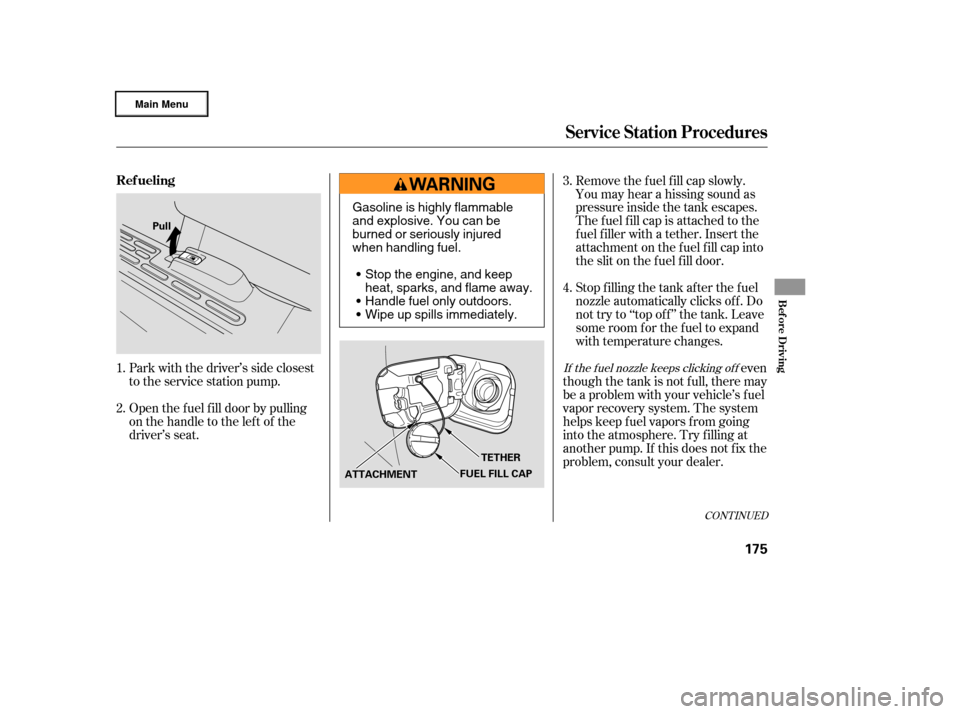Page 106 of 320

�µIf the driver’s
window senses any obstacle while it
is closing automatically, it will
reverse direction and then stop. To
close the window, remove the
obstacle, then use the window switch
again.
Auto reverse stops sensing when the
window is almost closed. You should
always check that all passengers and
objects are away from the window
bef ore closing it. Your vehicle has a power back
window.
This indicator comes on when you
turn the ignition switch from ON (II)
to ACCESSORY (I) or LOCK (0)
without closing the back window.
With the ignition switch in the
ACCESSORY (I) position, the
indicator goes of f af ter about 30
seconds. With the ignition switch in
the LOCK (0) position, the indicator
goes of f af ter about 3 minutes.
If the driver’s window f use is
removed, the AUTO f unction may be
disabled. The power window system
needs to be reset af ter reinstalling
the fuse.
Start the engine. Push down and
hold the driver’s window switch
until the window is f ully open.
Pull and hold the driver’s window
switch to close the window
completely, then hold the switch
f or a second or two more.
If the power windows do not operate
properly af ter resetting, have your
vehicle checked by your dealer. 1.
2.
CONT INUED
AUTO REVERSE Back Window
Back Window Open
Indicator
Power Windows
Inst rument s and Cont rols
103
�����—�
���—�����y�
�������������y���
�(�����������y���
�����y
Page 127 of 320

The heater uses engine coolant to
warm the air. If the engine is cold, it
will be several minutes bef ore you
f eel warm air coming f rom the
system.Air conditioning places an extra load
on the engine. Watch the engine
coolant temperature gauge (see page
). If it moves near the red zone,
turn of f the A/C until the gauge
reading returns to normal.
Turn on the A/C by pressing the
button. The display shows A/C
ON on when a f an speed is
selected.
Make sure the temperature is set
to maximum cool.
Select .
If the outside air is humid, select
recirculation mode. If the outside
air is dry, select f resh air mode.
Set the f an to the desired speed. you can
cool it down more rapidly by partially
opening the windows, turning on the
A/C, and setting the fan to
maximum speed in f resh air mode.
To cool the interior with MAX A/C:
Select .
When you select , the system
automatically switches to the fresh
air mode.
Set the f an to the desired speed.
Adjust the warmth of the air with
the temperature control dial. Set the f an to the desired speed.
Select MAX A/C mode.
The system automatically turns on
the A/C, selects , and
switches to recirculation mode.
Make sure the temperature is set
to maximum cool.
1.
2.
3.
1.
2.
3.
1.
2.
3.
4.
5. 69
If the interior is very warm,
On RT and Canadian LX modelsUsing the Heater Using the A /C
Vents, Heating, and A/C
124
�����—�
���—�����y�
�������������y���
�(�����������y���
�����y
Page 176 of 320
Bef ore you begin driving your
vehicle, you should know what
gasoline to use and how to check the
levels of important f luids. You also
need to know how to properly store
luggage or packages. The
inf ormation in this section will help
you. If you plan to add any
accessories to your vehicle, please
read the information in this section
first..............................
Break-in Period .174
.................
Fuel Recommendation .174
.........
Service Station Procedures .175
....................................
Ref ueling .175
Opening and Closing the
.......................................
Hood .177
...................................
Oil Check .178
.............
Engine Coolant Check .178
...............................
Fuel Economy .179
...
Accessories and Modif ications .180
.............................
Carrying Cargo .182
Bef ore Driving
Bef ore Driving
173
�����—�
���—�����y�
���������
���y���
�(�����������y���
�����y
Page 177 of 320

Help assure your vehicle’s f uture
reliability and perf ormance by paying
extra attention to how you drive
during the f irst 600 miles (1,000 km).
During this period:Avoid full-throttle starts and rapid
acceleration.
Do not change the oil until the
scheduled maintenance time. Avoidhardbrakingforthefirst
200 miles (300 km).
Do not tow a trailer.
You should also f ollow these
recommendations with an
overhauled or exchanged engine, or
when the brakes are replaced. Your vehicle is designed to operate
on unleaded gasoline with a pump
octane number of 86 or higher. Use
of a lower octane gasoline can cause
a persistent, heavy metallic rapping
noise that can lead to engine damage.
We recommended using a quality
gasoline containing detergent
additives that help prevent fuel
system and engine deposits.
In addition, in order to maintain good
perf ormance, f uel economy, and
emissions control, we strongly
recommend, in areas where it is
available, the use of gasoline that
does NOT contain manganese-based
f uel additives such as MMT.
Use of gasoline with these additives
may adversely af f ect perf ormance,
and cause the malfunction indicator
lamp on your instrument panel to
come on. If this happens, contactyour authorized dealer f or service.
Some gasoline today is blended with
oxygenates such as ethanol or
MTBE. Your vehicle is designed to
operate on oxygenated gasoline
containing up to 10 percent ethanol
by volume and up to 15 percent
MTBE by volume. Do not use
gasoline containing methanol.
If you notice any undesirable
operating symptoms, try another
service station or switch to another
brand of gasoline.
Premium f uel is recommended when
towing in certain conditions (see
page ).
For f urther important f uel-related
inf ormation, please ref er to your
.
215
Break-in Period Fuel Recommendation
Quick Start Guide
Break-in Period, Fuel Recommendation
174
�����—�
���—�����y�
�������������y���
�(�����������y���
�����y
Page 178 of 320

CONT INUED
Open the f uel f ill door by pulling
onthehandletotheleftof the
driver’s seat. Park with the driver’s side closest
to the service station pump.Stop f illing the tank af ter the f uel
nozzle automatically clicks of f . Do
not try to ‘‘top of f ’’ the tank. Leave
some room f or the f uel to expand
with temperature changes. Remove the f uel f ill cap slowly.
You may hear a hissing sound as
pressure inside the tank escapes.
The fuel fill cap is attached to the
f uel f iller with a tether. Insert the
attachment on the fuel fill cap into
the slit on the f uel f ill door.
even
though the tank is not full, there may
be a problem with your vehicle’s f uel
vapor recovery system. The system
helps keep f uel vapors f rom going
into the atmosphere. Try f illing at
another pump. If this does not f ix the
problem, consult your dealer.
1.
2. 3.
4.
If the f uel nozzle keeps clicking of f
Ref ueling
Service Station Procedures
Bef ore Driving
175
Pull
TETHER
FUEL FILL CAP
ATTACHMENT
Gasoline is highly flammable
and explosive. You can be
burned or seriously injured
when handling fuel.
Stop the engine, and keep
heat, sparks, and flame away.
Handle fuel only outdoors.
Wipe up spills immediately.
�����—�����—�����y�
����
��������y���
�(�����������y���
�����y
Page 181 of 320
Wait a f ew minutes af ter turning the
engine of f bef ore you check the oil.Remove the dipstick (orange loop).
Wipe of f the dipstick with a clean
cloth or paper towel.
Insert it all the way back in its hole. Remove the dipstick again, and
check the level. It should be
between the upper and lower
marks.
If it is near or below the lower mark,
see on page . Look at the coolant level in the
radiator reserve tank. Make sure it is
between the MAX and MIN lines. If
it is below the MIN line, see
on page .
Refer to on page f or inf ormation
about checking other items on your
vehicle.
1.
2.
3. 4.
236 239
231
Service Station Procedures
A dding Engine Oil Engine Coolant Check
Oil Check
A dding
Engine Coolant
Owner’s Maintenance
Checks
178
DIPSTICK
UPPER MARK
LOWER MARK MAX
MIN
RESERVE TANK
�����—�
���—�����y�
���������
���y���
�(�����������y���
�����y
Page 182 of 320

Always maintain your vehicle
according to the maintenance
messages displayed in the
inf ormation display. See(see page
).
an underinf lated tire
causes more ‘‘rolling resistance,’’
which uses more f uel.
The build-up of snow or mud on
your vehicle’s underside or on the
truck bed adds weight and rolling
resistance. Frequent cleaning
helps your f uel mileage and
reduces the chance of corrosion.
Drive moderately. Rapid
acceleration, abrupt cornering,
and hard braking use more f uel.
Always drive in the highest gear
possible. Try to maintain a constant speed.
Everytimeyouslowdownand
speed up, your vehicle uses extra
f uel. Use cruise control when
appropriate.
Combine several short trips into
one.
The air conditioning puts an extra
load on the engine which makes it
usemorefuel.Usethefresh-air
ventilation when possible.
231
For example,
Improving Fuel Economy
Owner’s
Maintenance Checks
Fuel Economy
Bef ore Driving
179
�����—�
���—�����y�
�������������y���
�(�����������y���
�����y
Page 192 of 320

This section gives you tips on
starting the engine under various
conditions, and how to operate the
automatic transmission. It also
includes important inf ormation on
parking your vehicle, the braking
system, the VTM-4system, the VSA
system, the tire pressure monitoring
system, and f acts you need if you are
planning to tow a trailer.........................
Driving Guidelines .190
........................
Preparing to Drive .191
.......................
Starting the Engine .192
..............
Automatic Transmission .193
Variable Torque Management
.........
4WD (VTM-4) System .198
..............................
VTM-4Lock .198
Tire Pressure Monitoring System ......................................
(TPMS) .199
...........................................
Parking .201
.............................
Braking System .202
...............
Anti-lock Brakes (ABS) .203
Vehicle Stability Assist (VSA)
........................................
System .205
.................
Towing Weight Limits .207
..........
Towing Weight Guidelines .209
...........................
Towing a Trailer .210
Of f -Highway Driving
..................................
Guidelines .219
Driving
Driving
189
�����—���
�—�����y�
�������������y���
�(�����������y���
�����y